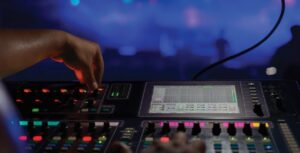When it comes to live streaming, what do you think it more important, video or audio? As churches have expanded their digital presence through live streaming services, video quality has become an important consideration. However, many overlook the even greater importance of having high-quality audio mixing for an engaging online viewing experience.
Despite video capturing visuals like the sermon, worship, and other elements, audio is the primary way the message and worship experience are conveyed for live streaming viewers at home. Poor audio mixing can significantly diminish that experience in several ways. (Keep reading for the 7 practice tips on how to improve).
Imbalanced Sound Levels
If vocals, instruments, or other audio sources are too loud or too soft compared to each other, it becomes fatiguing and distracting to listen to the live streaming for an extended time. Proper audio mixing balances all sound sources at appropriate levels.
Feedback, Hiss, and Other Artifacts
Ambient noise like feedback, hissing, buzzing, and electrical hums can make the audio experience unpleasant and unprofessional sounding. An experienced audio engineer adjusts mix levels and utilizes noise gating and other filters to clean up the audio.
Unclear Speech Clarity
When vocals and speech are muddied with too much bass, sibilance, or popping sounds, it becomes very difficult to understand what is being said clearly. Skilled mixing brings out clarity in speech while minimizing distracting artifacts.
Lack of Punch and Dynamics
Music and singing on a live streaming can fall flat without the proper dynamics processing like compression and limiting. An experienced audio mixer shapes the dynamics to give the audio more life and punch.
No Room Ambience
Simply pointing cameras at speakers can result in a very dry, Phase-y sound. Mixing in calibrated room ambience mics provides a much more natural, resonant sound environment.
With so much importance placed on audio for an engaging live streaming experience, it’s critical for churches to have an experienced audio engineer operating the mix. Mixing audio is both an art and a science that requires skill and experience to produce high-quality sound. The good news is you don’t need a degree to do this; you just need some practice and experience.
By the way, a great book that makes this very simple can be found at GreatChurchSound.com by James Wasem. You can watch the interview Church Solutions Podcast here.
But how?
Here are some practical ways to dial in and improve audio quality for live streaming church services:
1. Invest in quality microphones and proper microphone technique:
- Use high-quality vocal mics for speech/sermons and instrument mics for worship band
- Ensure mics are positioned properly and speakers are using good mic technique to avoid pops, sibilance, etc.
2. Utilize a skilled audio engineer for mixing:
- Don’t have a skilled audio engineer? Well, practice makes perfect as they say. Keep trying and you can get the hang of it, just don’t give up. I have seen people with no experience in audio mixing make lots of progress as they keep working on it. Having someone experienced at the audio mixer can balance levels, apply EQ, compression, etc.
- An engineer can dial in the right ambience mics and room sounds for a natural mix.
3. Implement a digital audio mixer with mixing capabilities:
- A digital mixer provides more flexibility for routing, effects, and processing than an analog mixer
- Look for mixers with noise gating, compression, EQ and effects like reverb
4. Treat the room acoustics:
- Add acoustic treatment (bass traps, diffusers, etc.) to improve the room’s sound
- This gives the audio engineer a better soundscape to capture
5. Check gain staging and eliminate noise:
- Properly gain stage preamps, mixers to avoid clipping or excessive noise floor
- Use quality cabling, DI boxes, and connections to prevent interference
6. Record ambient room mics:
- Having a pair of room mics can add needed ambient room tone
- The room mics get blended with close mics for a fuller, more natural sound
7. Use reference monitors for mixing:
- Having quality studio monitors helps the engineer properly mix and EQ
By focusing on the audio signal chain from mics to mixer to room treatment, and utilizing an experienced audio engineer, churches can really elevate their live streaming audio quality for an engaging experience.
We are here to partner with you. StreamingChurch.tv is here for you in 2024 and beyond! Reach out to us, since 2001 our seasoned ministry staff has worked exclusively with churches and ministries around the world. We have monthly webinars to equip you for ministry. Click here to learn more.
Check out our Church Solutions Podcast today and reach out to us anytime, at Support@StreamingChurch.tv or use live chat at the bottom right of your page
